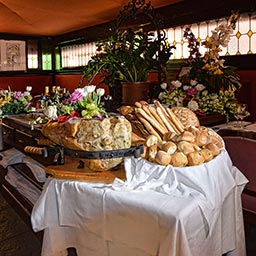
Menu
The Doge of Venice Ludovico Manin recommended: "Prawns and Scallops on a bed of rocket with a dressing of lemon, oil, salt and pepper."
Starters

Menu Starters
- Manin prawns and scallops (on a bed of rocket)
- Doge’s starter (shrimps, crab and mantis shrimp)
- Seasoned shrimps
- Crab served in shell
- Mantis shrimps with lemon
- Casanova scallops
- Smoked salmon
- Octopus and celery salad
- Steamed king prawns on a bed of raw artichokes
- Crayfish salad with crunchy vegetables
- Octopus carpaccio with balsamic vinegar
- Salted cod mousse with polenta
- Iranian caviar (50 g)
- Saor (marinated) prawns
- Saor (marinated) sardines
- San Daniele Ham
- Hand sliced San Daniele Ham
- Casanova Carpaccio "with Casanova sauce"
- Dried salted beef with rocket salad and parmesan
- Caprese (with buffalo mozzarella and tomato)
- Nicoise salad
- “Assorted” vegetables from our garden
- “Butter and egg” asparagus Bismarck-style
RAW FISH
- Oysters (6 pieces)
- Tuna tartare
- Prawns and sea bass with herbs
- Giant prawns
- Mixed tuna, prawns and sea bass
Read all the menu
First courses

First courses
- Serenissima spaghetti (with shelled clams and courgettes)
- Seafood spaghetti (clams)
- Gradese spaghetti with mussels, cherry tomatoes and herbs
- Spaghetti carbonara
- Spaghetti all'isolana (island-style spaghetti)
- Vermicelli with garlic, oil, chili pepper
- Fresh Tagliolini pasta with prawns and asparagus spears
- Bucatini pasta with Amatriciana sauce
- Tintoretto linguine (with crayfish sauce)
- Tagliatelle with Bolognese sauce
- Dogaressa Tortellini (with vegetables)
- Agnolotti filled with ricotta and spinach in black butter
Risottos
- Black ink risotto with harbour cuttlefish
- Titian risotto with prawns and champagne
- Seafood risotto
- Torcellana risotto (with legumes from the lagoon)
- Risotto with St. Erasmus artichokes
Gratins
- Lasagna bake with veal ragù sauce
- Ortolana tagliolini (au gratin with vegetables from the lagoon)
- Aubergine parmigiana bake
Soups
- Adriatic Sea fish soup
- Mussel soup
- Vegetable soup
- Onion soup au gratin
- Venetian-style pasta and bean soup
- “Grandma’s tortellini”
- Cup of consommé
- Porcini mushroom soup
Read all the menu
Second courses

Second courses
Food of the Gods
- Grilled sirloin steak (per 100g) min. 600 g.
- Maitre d'Hotel grilled beef sirloin
- Grilled beef fillet steak
- Beef fillet Voronoff-style
- Beef fillet Tartare
- Beef fillet Stroganoff
- Chateaubriand
- Sliced beef with rosemary
- Milanese cutlet
- Milanese-style veal cutlet
- Roasted veal shanks
- Braised veal shanks (osso buco) Senator-style
- Roast lamb
- Venetian-style liver
- Provence-style chicken breasts
- Sautéed kidneys with “black mustard”
Fish
- Mediterranean-style sea bream
- Baked turbot or sea bass with potatoes, cherry tomatoes and black olives (per 100g)
- Rockfish stew (per 100 g.)
- Breton prawns (with pilaf rice)
- “Ducale” John Dory fillets
- “Ca d'Oro” sole fillets
- Venetian-style harbour cuttlefish
- Sea bass baked in salt (per 100 g.)
Fried delicacies
- Do Forni fried delicacies
- Golden fried giant prawns Fantin-style
- Local squid
Boiled fish
- Steamed sea bass (per 100 g.)
- Giant prawns on a bed of artichoke
- Lobster or crayfish (per 100 g.)
Grilled fish
- Sea bass (per 100 g. )
- Mixed grilled fish
- Monkfish
- Adriatic Sea sole - grilled or meunière
- Giant prawns
- Lobster or crayfish (per 100 g.)
- Sliced yellow fin tuna steak
Read all the menu
Sides

Sides
Vegetable
- Mixed salad
- Green salad (radicchio and rocket)
- Tomato salad
- Crudités with dip
- Rocket salad from our garden
- Freshly picked salad
- French fries
- Spinach
- Peas from our garden with butter
- Green asparagus with Parmesan cheese
- Sautéed mushrooms
- St. Erasmus artichokes
Selection of cheeses from the cart
Read all the menu
Desserts

Desserts
Desserts
- Grand Marnier Soufflé with vanilla and chocolate (min. 2 people - cooking time 45 minutes)
- “Do Forni” crepes
- Dessert trolley cakes from the Do Forni patisserie (fruit tarts, Sachertorte, Do Forni meringues, “Veneziana” cake)
- Fior di Latte ice cream with hot chocolate
- Tiramisu
- Creme caramel
- Fruits of the forest Bavarois
- Amor di Pera (pear dessert)
- Wild strawberries with lemon sauce
- Wild strawberries with balsamic vinegar
- Azorean pineapple with Maraschino liqueur
- Assorted fruit sorbets
- Peach Melba
Read all the menu
THE WINE CELLAR
The restaurant has a large and well-appointed wine cellar; personally supervised by the Paties family, our wine cellar offers our clientele the finest wines from all the Italian regions, the most prestigious French wines and champagnes, as well as a wide selection of wines from international vineyards.

Traditional Venetian cuisine, mainly seafood, offering fish and shellfish from the Adriatic Sea.

A refined interpretation of Venetian and Italian cuisine.

Our cuisine combines the use of local meats and vegetables with the influence of international gastronomy.
The Restaurant
“The pleasure of taste begins at Do Forni, to rediscover the flavors of the most tempting culinary creativity.”
The history of Do Forni restaurant hails back to the most characteristic and ancient traditions of the city. During the golden years of the Venetian Republic the bakery producing bread and sweets for the nearby convent of San Zaccaria (the Doge's Palace) was located here, in fact, and a small part was used as a typical Venetian tavern (with cicchetti appetizers). After the fall of the Venetian Republic in 1797, the tavern was expanded to include the area previously used as bakery. It became a restaurant in the nineteenth century under its current name and it has been under the care of Mr Eligio Paties since 1973. Through his passionate vocation, understanding of the cultural importance of cuisine, and his innate hospitality, he has successfully turned Do Forni into a popular destination for all those who travel to Venice and wish to experience the noblest traditions of Venetian hospitality. Do Forni Restaurant offers a traditional and elegant setting in its Venetian-style rooms, and luxurious in those rooms that faithfully reproduce the hospitality of an Orient Express dining car.

The restaurant is listed in the food guides of the best restaurants in Italy.
Cuisine
Do Forni features traditional Venetian cuisine, mainly based on seafood, with a menu offering fish and shellfish from the Adriatic Sea using centuries-old Venetian recipes enhanced by seasonal vegetables and delicate sauces, but also a refined interpretation of both Venetian and Italian cuisine that is influenced by international gastronomy in its preparation of local meats and vegetables.
Visit the photo gallery of our dishes.
Do Forni graphic Art Prize
Since 1986, the DO FORNI restaurant has revived the “Art Restaurant” tradition by creating the Do Forni International Prize for Graphic Art.
Photogallery
Awards and Events
The elegance of the restaurant and the careful preparation and presentation of all foods have earned Do Forni restaurant numerous prizes and international awards.
Do Forni International Prize for Graphic Art and other events
Since 1986, the DO FORNI restaurant has revived the tradition of the “Art Restaurant” by creating the International Prize for Graphic Art, awarded to two artists - one Italian and one international - selected from a shortlist of twenty invited participants, during the annual ceremony hosted at important locations in the city.
The works of the winning artists of all editions of the Do Forni International Prize for Graphic Art are on permanent display in the rooms of the restaurant.
Albo d'Oro
| 1986 | Miguel Rodriguez Acosta | Spain |
| Giuseppe Zigaina | Italy | |
| 1987 | Bertrand Dorny | France |
| Francesco Vaccarone | Italy | |
| 1988 | Vladimir Velickovic | Yugoslavia |
| Aldo Turchiaro | Italy | |
| 1989 | Jean Michel Folon | France |
| Emilio Tadini | Italy | |
| 1990 | Rainer Mordmuller | Germany |
| Luca Crippa | Italy | |
| 1991 | Adolf Frohner | Germany |
| Riccardo Licata | Italy | |
| 1992 | Albin Brunovsky | Czechoslovakia |
| Carmelo Zotti | Italy | |
| 1993 | Joze Ciuha | Slovenia |
| Aligi Sassu | Italy | |
| 1994 | Aduardo Arroyo | Spain |
| Bruno Ceccobelli | Italy | |
| 1995 | Joe Tilson | Great Britain |
| Giuliano Viaggi | Italy | |
| 1996 | Beverly Pepper | United States |
| Marco Lodola | Italy | |
| 1997 | Kyoji Nagatani | Japan |
| Sergio Vacchi | Italy | |
| 1998 | Roger Selden | United States |
| Fabrizio Plessi | Italy | |
| 1999 | Miguel Berrocal | Spain |
| Concetto Pozzati | Italy | |
| 2000 | André Verdet | France |
| Ugo Nespolo | Italy | |
| 2001 | Alberto Gianquinto | Italy |
| Kengiro Azuma | Japan | |
| 2002 | Enrico Baj | Italy |
| Hsiao Chin | China | |
| 2003 | Sandro Chia | Italy |
| Igor Mitoraj | Poland | |
| 2004 | Edo Murtic | Croatia |
| Mimmo Rotella | Italy | |
| 2005 | Safet Zec | Bosnia |
| Salvo | Italy | |
| 2006 | Ludovico De Luigi | Italy |
| 2007 | Peter Blake | Great Britain |
| 2008 | Mimmo Paladino | Italy |
| 2009 | Valerio Adami | Italy |
| 2010 | Giulio Paolini | Italy |
| 2011 | Joe Tilson | Great Britain |
| 2012 | Sandro Chia | Italy |
| 2013 | Walter Valentini | Italy |
Casanova
Do Forni restaurant commemorated the second centenary of the death of Giacomo Casanova by creating a dedicated menu with recipes inspired by the era of the great Venetian adventurer and writer. Food and recipes described in this publication actually come from original eighteenth century recipe books and include many curiosities about the culinary customs and the cultural traditions of Venice at that time.
The dishes on the menu were prepared and presented to the public during the many events organized in Venice all year round. All the illustrations in the menu are the work of the Venetian artist Ludovico De Luigi.
Guest Book
- Francesco De Martino
- Mario Rigo
- Giovanni Pieraccini
- Francesco Badoglio
- Michele Pellicani
- Bettino Craxi
- Principessa Margaret d’Inghilterra -
Countess of Snowdon - Armando Cossutta
- Alessandro Natta
- Mario Bisaglia
- Giancarlo Pajetta
- Giovanni Berlinguer
- Sandro Pertini
- Diana Spencer
- Prince Charles
- Maria Pia of Savoy
- Maria Gabriella of Savoy
- Prince Michel of Bourbon-Parma
- Marie Alfonsin
- Nilde Jotti
- Franz Josef Smith
- Maria José of Savoy
- Ugo Bergamo
- Richard Nixon
- Prince and Princess Michael of Kent
- Moshe Shahael
- Michele of Greece
- Sean Kennedy Smith
- Caroline of Monaco
- Generale Schwarzkopf
- Margherita Boniver
- Silvio Berlusconi
- Massimo Cacciari
- Oscar Luigi Scalfaro
- Clemente Mastella
- Lamberto Dini
- Bartholomew I Ecumenical Patriarch of Constantinople

.png)

































